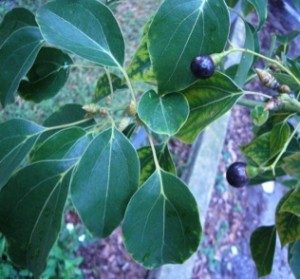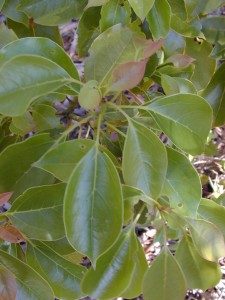Campy Camphor: Not Just For Grandma
One would never guess Camphor trees are not native to Florida, or the South. One also probably wouldn’t guess they are closely related to the cinnamon tree, either.
The Camphor has a split personality: Folks either like a lot, or dislike it a lot. There’s little middle ground. First it grows huge, and fast. This upsets controlled garden folks who don’t like their planned pallet colored by a rambunctious upstart. Then there are the berries and hundreds of seedlings every year. Whether pal or pest is a matter of attitude and perspective.
The young leaves and shoots of the Camphor can be boiled and eaten. The roots of the young shoots are used to make a tea. Older leaves can be used as a spice. But go easy, they are toxic in large doses. All parts contains chemicals that can stimulate the central nervous system. This can affect respiration or cause convulsions. In Chinese medicine, pregnant women are not allowed Camphor in any form at anytime.
While Camphor is not a common spice flavor today it has been used a lot in the past and was popular in Europe until the Renaissance. Camphor wood, or leaves and twigs, is used to make a popular Szechuan smoked duck. Camphor oil has been used in commercial baked goods, beverages, and candy. It has also been added to milk puddings and confections. In fact, it is an ingredient in Swedish Bitters. Why use camphor oil, or a fractal of it? It contains safole, the essential oil in sassafras which used to be a main flavor in root beer.
If you are not consuming parts of the Camphor tree it makes excellent wood for clothes bureaus, naturally driving away insects. Camphor is a native to Japan, China, Taiwan and northern Vietnam and was introduced into Florida in 1875, which is rather amazing consider how large some of the specimens are today, some 139 years later. There were actually Camphor tree plantations. Now the state calls the Camphor an “exotic pest plant” yet it is still sold in nurseries and other stores. It is naturalized in Alabama, California, Florida, Georgia, Hawaii, Louisiana, Mississippi, North Carolina, Texas and South Carolina. In Australia, where it was introduced in 1822, it is officially a noxious weed. It also grows in the Caribbean. Camphor is, as mentioned earlier, a source of safrole, a banned oil that used to come from the sassafras tree. And of course the tree is the source of Camphor oil, which is one of the ingredients in Tiger Balm.
The scientific name is Cinnamomum camphora. Cinnamomum (sin-uh-MOE-mum) comes from the Greek word ‘kinnamomon’ meaning spice. Camphora (kam-FOR-uh in Latin) is also Greek and comes from the ancient word for the tree, kamfora (except the Greek pronunciation puts the accents the end, kam-for-AH.)
The wood itself, which is steamed to collected the oil, has red and yellow striping making it a favorite of wood workers. The tree is also very resistant to hurricanes and is the official tree of Hiroshima, Japan.
Green Deane’s “Itemized” Plant Profile
IDENTIFICATION: Leaves, alternate, evergreen, simple, oval to elliptical, 5 inches, usually less, edges can be somewhat wavy, dark glossy green above, pale below, with three prominent veins, camphor odor when crushed. Leaves are pink when young. Fruit appear in autumn, dark blue to black, round, fleshy drupes; usually produced in excess. Not edible. The bark is reddish brown and variable. The trunk can reach six feet through, and the tree can grow to 70 feet tall.
TIME OF YEAR: Young leaves anytime, shoots when sprouting, usually spring but not exclusively.
ENVIRONMENT: Open spaces with plenty of sun and adequate. Does not like its feet wet.
METHOD OF PREPARATION: Young leaves and shoots boiled. Shoots used to make tea, older leaves as a spice. Use in moderation. Twigs, leaves and wood can be used to add a smokey flavor to food.
HERB BLURB
Camphor oil has a strong fragrance, a bitter flavor, and feels cool on the skin. It can irritating and numbing. It has been used to treat everything from parasites to toothaches. Research shows Camphor is antiseptic and can be used for treating diarrhea, inflammation, itching, and some nervous conditions.




